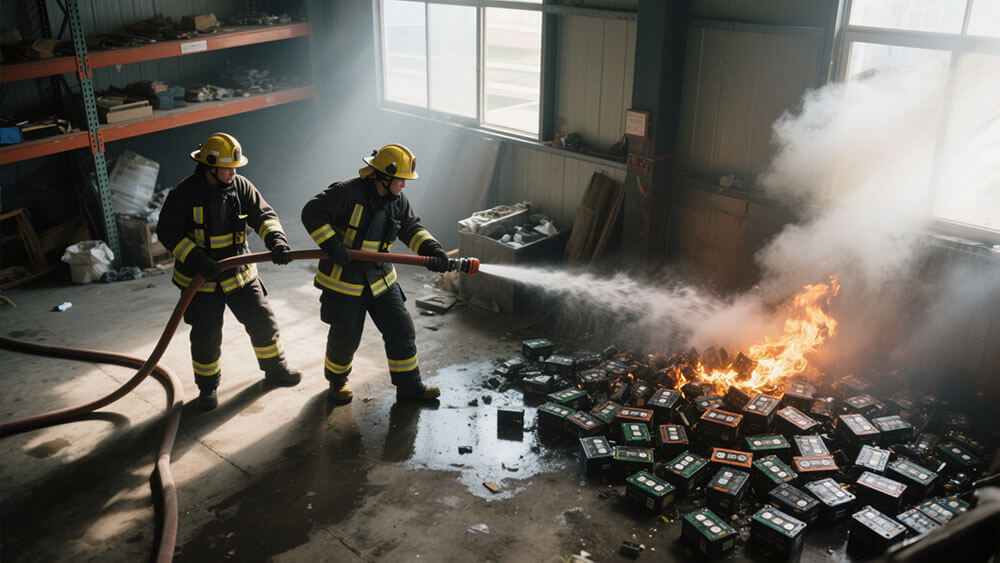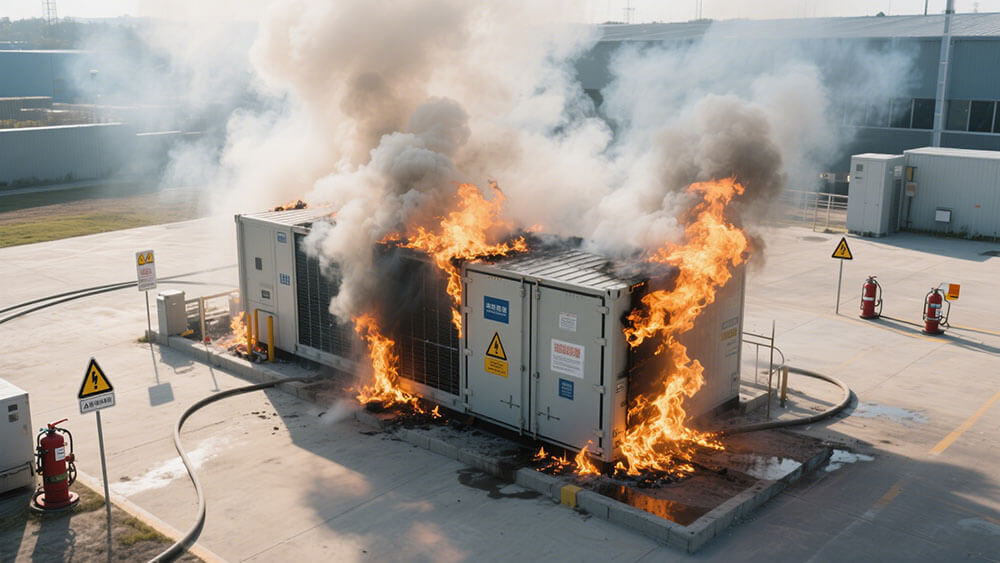
Lithium battery fires are a growing concern due to their frequency and severity. These fires often require ten times more water to extinguish compared to gas fires. In major cities like New York, over 660 incidents involving lithium batteries occurred in just six years, causing 12 deaths and more than 260 injuries. Responders must address challenges like reignition and thermal runaway, making proper training and protocols essential for safety. You need to act quickly and knowledgeably to prevent catastrophic outcomes.
Key Takeaways
Check the situation before trying to put out a lithium battery fire. Stay safe and wear safety gear to avoid harmful gases.
Use the right extinguisher for the battery type. For lithium-ion fires, use ABC or dry powder extinguishers. For lithium-metal fires, use a Class D extinguisher.
Watch the area after putting out the fire. Lithium battery fires can start again because of leftover heat. Keep tools close and stay alert.
Part 1: Immediate Steps to Put Out a Lithium Battery Fire

1.1 Assess the Situation and Ensure Safety
When a lithium battery fire occurs, your first priority should be to assess the situation and ensure safety. Lithium-ion batteries can undergo thermal runaway, a dangerous chain reaction that leads to intense heat, jet fires, or even explosions. Before attempting to extinguish the fire, evaluate the surrounding environment. Identify potential hazards, such as flammable materials or confined spaces, which could amplify the risks.
If the fire is small and contained, you may proceed with suppression. However, for larger fires or those involving multiple battery packs, evacuate the area and contact emergency services immediately. Always wear personal protective equipment (PPE), such as gloves and goggles, to shield yourself from toxic gases like hydrogen fluoride and carbon dioxide. These gases, released during thermal runaway, pose significant health risks, especially in enclosed spaces.
Tip: Keep a fire-resistant container nearby to isolate overheating batteries. This precaution can prevent the spread of flames and reduce the risk of explosion.
1.2 Recommended Extinguishing Agents for Lithium-Ion Battery Fires
Choosing the right fire suppression agent is critical to stop a lithium-ion battery fire effectively. Lithium-ion battery fires are classified as Class B fires, which involve flammable liquids. For these fires, standard ABC or dry chemical fire extinguishers are highly effective. Clean agent fire suppression systems also offer a reliable solution due to their rapid action and non-conductive properties. These systems suppress fires in under ten seconds, leave no residue, and are environmentally friendly, complying with NFPA 2001 and NFPA 12 standards.
For lithium-metal fires, which react violently with water, a Class D fire extinguisher is essential. These extinguishers contain specialized agents like sodium carbonate or powder graphite, designed to smother and cool the fire. The table below summarizes findings from scientific studies on effective extinguishing agents:
Study | Findings |
|---|---|
Majeed et al. (2024) | Highlighted design principles for fire-suppressing agents in lithium fires. |
Yuan et al. (2021) | Evaluated various fire-extinguishing agents for lithium-ion battery fires. |
Babushok et al. (2017) | Found dipotassium carbonate more efficient than potassium bicarbonate. |
van Wingerden et al. (2023) | Suggested aerosol size impacts suppression effectiveness. |
1.3 Step-by-Step Guide to Extinguishing a Lithium Battery Fire
Follow these steps to put out a lithium battery fire safely and effectively:
Identify the Fire Type: Determine whether the fire involves lithium-ion or lithium-metal batteries. This distinction will guide your choice of extinguishing agent.
Use the Appropriate Extinguisher: For lithium-ion battery fires, deploy a standard dry chemical or ABC fire extinguisher. For lithium-metal fires, use a Class D fire extinguisher.
Apply Suppression Agents: Use foam, such as aqueous film-forming foam (AFFF), to smother the fire and prevent reignition. Alternatively, apply dry chemical agents like sodium bicarbonate or potassium bicarbonate to interrupt the chemical reaction.
Cool the Device: If the fire is small, cool the overheating device with water or a non-alcoholic liquid. Continue cooling for at least 15 minutes to prevent thermal runaway.
Monitor for Reignition: Lithium-ion battery fires can reignite due to residual heat. After extinguishing the flames, monitor the area closely and keep suppression tools on hand.
Evacuate if Necessary: If the fire spreads or becomes uncontrollable, evacuate immediately and call emergency services.
Note: Tests by the FAA have shown that water effectively extinguishes burning electrolytes from lithium-ion cells and halts thermal runaway propagation. However, water alone may not suffice for larger fires.
By following these steps, you can stop a lithium-ion battery fire while minimizing risks to yourself and others. Always prioritize safety and use the most effective battery fire suppressant available.
Part 2: Why Lithium-Ion Battery Fires Are Dangerous

2.1 Understanding Thermal Runaway in Lithium-Ion Batteries
Thermal runaway is one of the most critical safety hazards associated with lithium-ion batteries. This phenomenon occurs when internal damage or external factors, such as overheating or mechanical abuse, cause a rapid increase in temperature. The heat triggers a chain reaction, leading to the release of flammable and toxic gases, smoke, and even explosions.
Mechanical abuse, such as puncturing or crushing, can initiate thermal runaway in lithium-ion batteries. Internal damage generates heat, which can escalate into leakage, combustion, or even a full-blown lithium-ion battery fire. Larger batteries, like those used in electric vehicles, pose an even greater risk. They can release enough gas during thermal runaway to cause structural damage or serious injuries.
Findings | Description |
|---|---|
Explosion Hazard | The accumulation of thermal runaway gas poses an explosion hazard when lithium-ion batteries fail. |
Battery Size Impact | Larger batteries, such as those in electric vehicles, can produce enough gas to damage structures and risk injury. |
Data Availability | The data is accessible to the public through an online repository. |
Understanding thermal runaway is essential for mitigating the risks of lithium battery fires. By recognizing the triggers, you can take proactive steps to prevent these dangerous chain reactions.
2.2 Risks of Flammable Gases and Reignition
Lithium-ion battery fires release flammable and toxic gases, including hydrogen fluoride and carbon monoxide. These gases not only fuel the fire but also pose serious health risks. In confined spaces, the accumulation of these gases can lead to explosions or suffocation.
Reignition is another significant danger. Even after a lithium-ion battery fire appears extinguished, residual heat can cause the fire to reignite. This makes monitoring the affected area crucial. You should always keep suppression tools nearby and remain vigilant for signs of smoldering or smoke.
Tip: Ventilate the area thoroughly after extinguishing a fire to disperse harmful gases and reduce the risk of explosion.
2.3 Challenges in Extinguishing Lithium-Ion Battery Fires
Extinguishing lithium-ion battery fires presents unique challenges. These fires require intensive cooling to manage the heat generated by thermal runaway. Standard fire extinguishers may not always suffice, especially for larger fires. Additionally, the risk of reignition complicates firefighting efforts.
Firefighters face several obstacles, including:
Risks of reignition after the fire is extinguished.
Potential chemical exposure from flammable and toxic gases.
Complex vehicle designs that hinder access to battery packs.
To address these challenges, experts recommend establishing safety zones, implementing advanced cooling techniques, and collaborating with manufacturers to improve firefighting strategies. Training programs for emergency responders and familiarity with electric vehicle shutdown procedures can also enhance safety during lithium-ion battery fire incidents.
By understanding these challenges, you can better prepare for and respond to lithium battery fires, minimizing risks to life and property.
Lithium battery fires demand swift action and the correct extinguishing agents to minimize harm. Effective suppression techniques rely on mechanisms like oxygen displacement, heat isolation, and gas disruption. The table below highlights these functions:
Function | Description |
|---|---|
Oxygen Displacement | Covers the fire load, displacing oxygen and starving the fire of fuel. |
Phase Change and Isolation | Melts at ~1500°F, acting as a heat sink and forming a hard shell around the fire. |
Flammable Gas Disruption | Breaks down flammable gases into smaller concentrations, reducing flammability. |
Sorbency of Fire Gases | Binds to flammable molecules, limiting their contribution to ignition or toxicity. |
Understanding the causes of lithium battery fires is crucial for prevention. You should always use the appropriate extinguishing agents. For lithium-metal battery fires, Class D extinguishers are essential. For lithium-ion battery fires, standard ABC extinguishers or foam with CO2 and powder graphite are effective. Businesses must adopt robust safety protocols and invest in fire prevention tools to protect lives and property.
Tip: Regular training and access to proper firefighting equipment can significantly reduce the risks associated with lithium battery fires.
FAQ
1. What should you do if a lithium battery starts overheating but hasn’t caught fire yet?
Place the battery in a fire-resistant container immediately. Move it to a safe, ventilated area. Monitor it closely for signs of smoke or swelling.
Tip: Always keep a fire-resistant container nearby for emergencies.
2. Can water be used to stop a lithium-ion battery fire?
Yes, water can cool the fire and stop thermal runaway. However, it may not be sufficient for larger fires. Use water alongside other recommended extinguishing agents.
3. How can you tell if a lithium battery is at risk of failure?
Look for warning signs like swelling, leakage, or unusual odors. If you notice these, isolate the battery and avoid using it further.
Note: Regular inspections can help you detect potential issues early. For professional guidance on lithium battery, visit Large Power.






